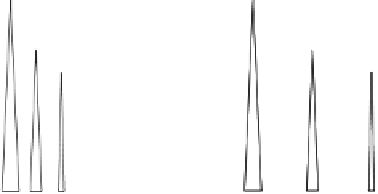Environmental Engineering Reference
In-Depth Information
mobile phase should be completely transparent at the required wavelength. Ultra
violet transparency is measured in terms of UV cutoff, which is defined as the
wavelength at which the absorbance of the solvent vs. air in 1-cm matching cells is
equal to unity. A practical tip is that if at all possible, the analysis wavelength should
be at least 20 nm above the UV cutoff of the solvent.
Solvent volatility (boiling point) is important only for evaporative light-
scattering detectors. Solvents with a high vapor pressure at the operating temperature
tend to produce vapor bubbles in the detector. If a differential refractometer detector
is used, then the solvent refractive index should be considered when selecting
solvents. Refractive index (RI) is a solvent's property in changing the speed of light.
It is computed as the ratio of the speed of light in a vacuum to the speed of light
through the solvent. The higher the RI, the slower the speed of light through the
solvent. Solvent refractive index (RI) affects the sensitivity of RI detection for a
particular sample. For better sensitivity, the RIs of both the solvent and the sample
should be as great as possible.
The last, but perhaps the most important solvent property in HPLC method
development, is the polarity that is directly related to separation. More polar solvents
cause increased retention in reverse phase HPLC and reduced retention in normal
phase HPLC. The solvents in Table 10.3 are arranged in an increasing order of
polarity index (P), which is a numerical measure of relative polarity of various
solvents. Polarity index (P) ranges from P ¼ 0 for a nonpolar solvent like pentane to
P ¼ 10
2 for the most polar solvent, water. Solvent strength increases as solvent
polarity decreases in reverse phase HPLC. Hence, in a decreasing order, the solvent
strengths are water (weakest)
:
<
acetonitrile
<
methanol
<
tetrahydrofuran
<
isopropyl alcohol
methylene chloride (strongest). The example below illustrates
how solvent polarity changes the separation in a reverse phase HPLC.
<
EXAMPLE 10.2.
Two hypothetical chromatograms, obtained by reverse phase HPLC
with a C
18
column and a UV detector, are shown in Figure 10.5. The left one shows the
chromatogram obtained with an isocratic 1:1 ratio of acetonitrile to water (50% each).
(a) Which of the three analytes is the most polar? (b) What change would you make in
order to increase the retention times for better spaced peaks as shown in the right
chromatogram?
A
A
B
B
C
C
Time Time
Figure 10.5
Effect of solvent polarity on the elution of analytes in HPLC







Search WWH ::

Custom Search